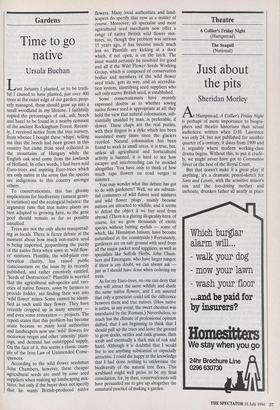Gardens
Time to go native
Ursula Buchan
Last January I planted, or to be truth- ful I caused to have planted, just over 400 trees at the outer edge of our garden; prop- erly managed, these should grow up into a small woodland in my lifetime. I faithfully copied the percentages of oak, ash, beech and hazel to be found in a nearby remnant of the ancient Rockingham Forest. Recent- ly, I received notice from the tree nursery, from whence I bought these 'whips', telling me that the beech had been grown in this country but came from seed collected in the mountains of Hungary while the English oak seed came from the lowlands of Holland. In other words, I had been sold Euro-trees and aspiring Euro-trees which are only native in the sense that the species are indigenous to this country amongst others.
. To conservationists, this has gloomy implications for biodiversity (natural genet- ic variation) and the ecological balance: the argument runs that true native plants are best adapted to growing here, so the gene pool should remain as far as possible unsullied.
. Trees are not the only aliens masquerad- ing as locals. There is fierce debate at the moment about how much non-native seed is being imported, jeopardising the purity of the native flora when sown in 'wild flow- er' mixtures. Plantlife, the wild-plant con- servation charity, has raised public consciousness on the issue by its recently published, and rather emotively entitled, 'Seeds of Destruction?' Plantlife is worried that the agricultural sub-species and vari- eties of native flowers, sown by farmers to provide fodder, are finding their way into 'wild flower' mixes. Some cannot be identi- fied as such until they flower. They have recently cropped up in many amenity — and even some restoration — projects. The report states that this problem has become acute because so many local authorities and landscapers now use 'wild' flowers for motorway verges and other 'amenity' plant- ings, and demand has outstripped supply. On the face of it, this seems a classic exam- ple of the Iron Law of Unintended Conse- quences.
According to the wild flower seedsman John Chambers, however, these cheaper
agricultural seeds are used by some seed suppliers when making up landscaping mix- tures, but only if the buyer does not specify that he wants British-produced native
flowers. Many local authorities and land- scapers do specify that now as a matter of course. Moreover, all specialist and most agricultural seed merchants now offer a range of native British wild flower mix- tures, so, though this problem was serious 15 years ago, it has become much much less so. Plantlife are kicking at a door which, if not open, is on the latch. The issue would certainly be resolved for good and all if the Wild Flower Seeds Working Group, which is composed of conservation bodies and members of the wild flower seed trade, gets its way, and an accredita- tion system, identifying seed suppliers who sell only native British seed, is established.
Some conservationists have recently expressed doubts as to whether sowing native flower seed is appropriate at all; they hold the view that natural colonisation, sub- stantially unaided by man, is preferable, if slower. These chaps are the real purists, with their fingers in a dyke which has been inundated many times since the glaciers receded. Natural colonisation has been found to work in small areas, it is true, but, unless all agricultural and horticultural activity is banned, it is hard to see how escapes and interbreeding can be avoided altogether. You have only to think of how much rape flowers on road verges in summer.
You may wonder what this debate has got to do with gardeners? Well, we are substan- tial consumers of wild flower seed mixtures and wild flower 'plugs', mainly because natives are attracted to wildlife, and it seems to defeat the object if we buy seed from abroad. (There is a glaring illogicality here, of course, for we grow thousands of exotic species without batting eyelids — some of which, like Himalayan balsam, have become naturalised in the countryside.) Fortunately, gardeners are on safe ground with seed from all the major packet seed suppliers, as well as specialists like Suffolk Herbs, John Cham- bers and Emorsgate, who have larger ranges; if there is any doubt, we can always ask — just as I should have done when ordering my trees.
As for my Euro-trees, no one can deny that they will attract the same wildlife and shade the same native flowers, and I am assured that only a geneticist could tell the difference between them and true natives. (How native is native, in any event; the sweet chestnut was introduced by the Romans.) Nevertheless, so much has the climate of professional opinion shifted, that I am beginning to think that I should pull up the trees and leave the ground to grow docks, nettles and rank grasses, then scrub and eventually a thick mix of oak and hazel. Although it is doubtful that I would live to see anything substantial or especially attractive, I could die happy in the knowledge that I had done nothing to undermine the biodiversity of the natural tree flora. This scrubland might well prove to be my final consolation, for, by then, conservationists will have persuaded me to give up altogether the unnatural practice of making a garden.


















































 Previous page
Previous page